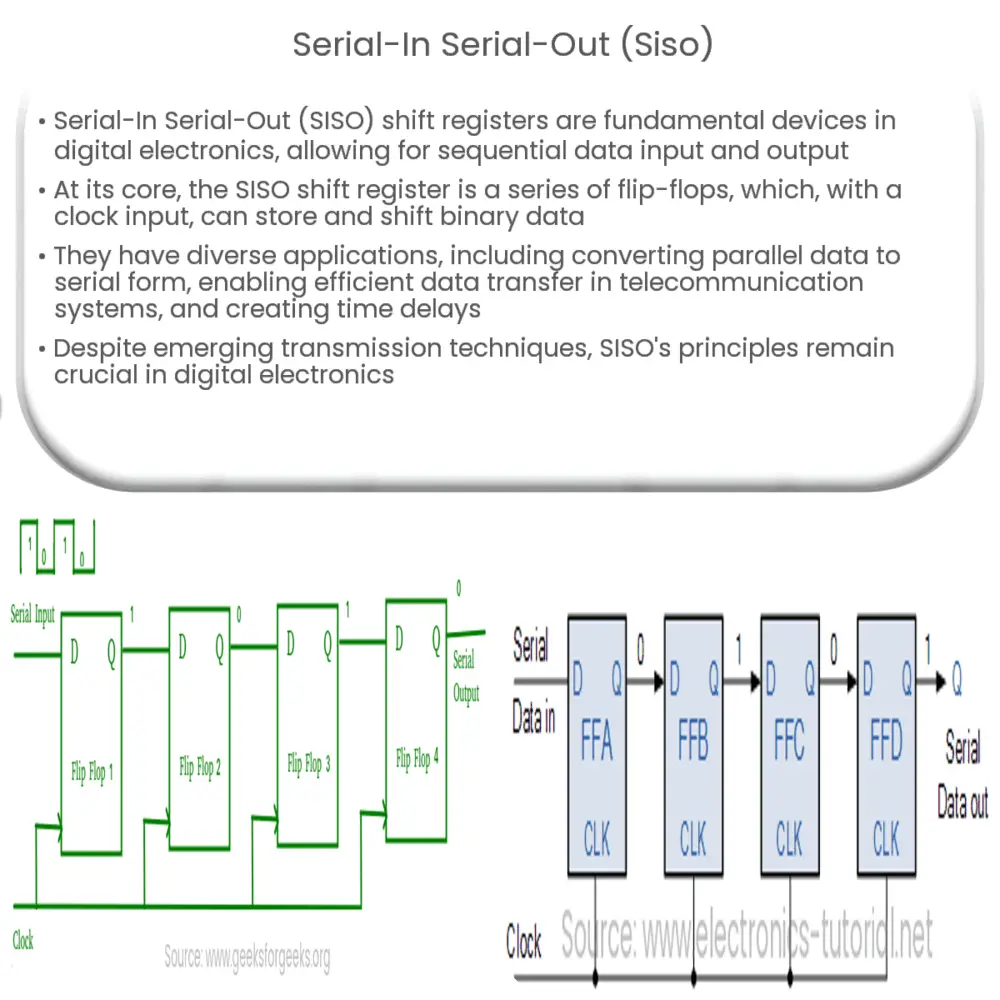Explore the workings of Serial-In Serial-Out (SISO) shift registers in digital electronics, their applications, and significance in data transmission.

Understanding Serial-In Serial-Out (SISO)
The world of digital electronics is governed by various data transmission techniques. One such widely used technique is the Serial-In Serial-Out (SISO) shift register, a type of device that allows data to be input and output in a sequential manner. This article delves into the workings of SISO shift registers, illustrating their functionality and role in digital electronic systems.
Basic Concept of SISO
Serial-In Serial-Out, as the name suggests, refers to the process where data input (Serial-In) and data output (Serial-Out) occur sequentially, one bit at a time. The fundamental unit of data is the ‘bit’, which can either be a 0 or a 1. In SISO shift registers, data bits are entered into the system in a serial (one after the other) fashion. After going through a certain process, these bits are then outputted, again in a serial manner.
The SISO Shift Register
At the heart of the SISO data transmission technique is the SISO shift register, an arrangement of flip-flops where the output of one flip-flop is connected to the input of the next. This linear sequence of flip-flops, paired with a clock input, creates a system that can store and shift binary data.
- Storage: SISO shift registers can store data bits. The number of bits they can store depends on the number of flip-flops in the arrangement. For example, a SISO shift register composed of 8 flip-flops can store 8 bits of data.
- Shifting: Upon receiving a clock input, the data bits are moved or ‘shifted’. Each clock pulse ‘shifts’ the stored data by one position. If the shifting is towards the output, it’s referred to as ‘shift right’. Conversely, if the shifting is towards the input, it’s referred to as ‘shift left’.
Applications of SISO
SISO shift registers find numerous applications in digital systems due to their unique data handling and storage capabilities. They are employed in systems requiring data delay or sequence generation. As part of a larger data transmission protocol, SISO shift registers aid in serial data communication, effectively converting parallel data streams into serial form, and vice versa.
Deeper Dive into Applications
In digital systems, SISO shift registers play a crucial role in data serialization and deserialization processes. They’re used extensively in telecommunication systems to allow for efficient data transfer over single transmission lines. Here are a few more specific examples:
- Serial Data Communication: SISO shift registers enable data bits to be transmitted serially over a communication network. This feature is particularly useful in scenarios where space and cost limit the use of parallel data transmission.
- Time Delay: SISO shift registers can create a time delay in the data stream. Each flip-flop in the shift register introduces a delay of one clock cycle. The total delay is the number of flip-flops times the clock period.
- Sequence Generation and Detection: SISO shift registers can generate and detect specific sequences of binary data, making them valuable in coding and cryptography applications.
Operation of SISO Shift Registers
The operation of SISO shift registers is based on the concept of shifting. Each clock pulse moves the stored data from one stage to the next. The ‘data in’ is entered into the first stage of the shift register, and as the data bits move or ‘shift’, they progress through each stage until they reach the ‘data out’ at the final stage.
The shift register’s data shifting ability is both its primary operation and its most distinctive feature. It’s this shifting operation that allows the SISO shift register to perform functions like time delay and sequence generation.
Conclusion
In conclusion, Serial-In Serial-Out (SISO) shift registers are pivotal elements in the domain of digital electronics. Their ability to handle and store data serially provides the foundation for many digital systems and communication protocols. Despite the rise of more advanced data transmission techniques, the principles and applications of SISO remain relevant and vital. From data serialization to sequence generation, SISO shift registers exemplify the beauty of simplicity and functionality in the world of digital electronics.

